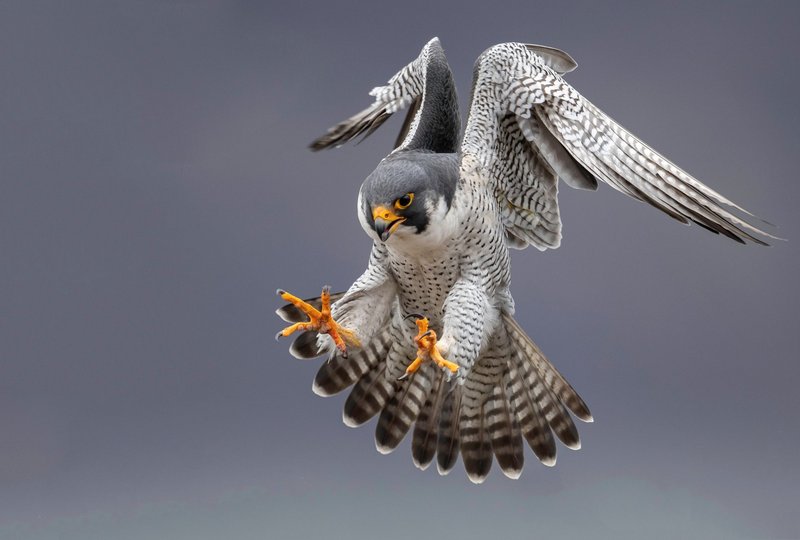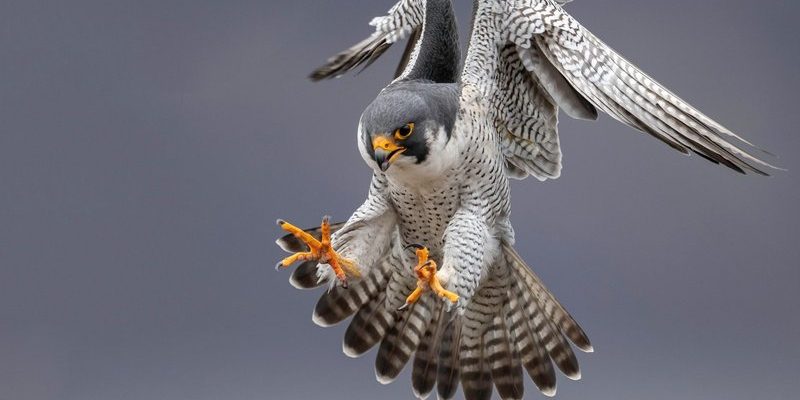
Let’s dive into the fascinating world of falcons. Whether you’re a birdwatching enthusiast or just curious about nature’s wonders, these incredible facts will give you a deeper appreciation for these magnificent birds. From their unique hunting techniques to their impressive adaptations, there’s so much to learn about falcons that will make your heart soar—just like they do!
1. The Speed Demons of the Sky
Here’s the thing: when it comes to speed, falcons are unmatched. The Peregrine Falcon holds the title for the fastest bird and, indeed, the fastest animal on the planet. In a hunting dive, called a stoop, these birds can reach speeds of over 240 miles per hour! Imagine the rush of wind as they plummet toward their prey, eyes locked in on their target.
This incredible speed is not just for show. As a top predator, the Peregrine Falcon relies on its swift movements to catch and kill smaller birds mid-flight. Think of them as the race cars of the avian world. Their streamlined bodies and pointed wings help them cut through the air efficiently, allowing them to close in on their dinner in a blink of an eye.
2. Amazing Vision
Falcons have extraordinary eyesight—so good that they can spot a rabbit from over a mile away! Their eyes are specially designed to focus on moving objects like a predator stalking its prey. In fact, a falcon’s vision is eight times sharper than that of a human. This means they can detect slight movements and even see in colors beyond what we can perceive.
What’s fascinating is that falcons possess a special structure in their eyes called a fovea, which enhances their visual acuity. This allows them to lock in on the smallest details while flying at breakneck speeds. You might be wondering how they manage to fly so fast without crashing. Their keen eyesight allows them to navigate and dodge obstacles effortlessly, turning them into true aerial acrobats.
3. The Art of Hunting
Falcons are expert hunters, and their hunting techniques are nothing short of spectacular. They typically hunt by soaring high above open fields or forests, scanning the ground for potential prey. Once they spot something worth pursuing, they dive down at incredible speeds to catch their dinner.
Most falcons eat small birds, but their diet can include insects, rodents, and even lizards. The way they catch their food is quite impressive. Some falcons use their feet to grab their prey mid-air or even knock them out of the sky with a swift strike. Imagine a football player leaping to catch a pass, but in this case, the falcon is catching dinner instead!
4. Diverse Species Across The Globe
Did you know there are over 60 species of falcons around the world? While they share common traits, each species has its unique behaviors and habitats. For instance, the Saker Falcon is known for its size and is often found in open grasslands and deserts, while the Merlin Falcon is smaller and prefers wooded areas.
Some species are even migratory, traveling thousands of miles between their breeding and wintering grounds. The Eleonora’s Falcon is fascinating for its migratory behavior, as it often hunts on islands and breeds in remote Mediterranean cliffs. This diversity makes falcons versatile and adaptable to various environments.
5. Strong Family Ties
Falcons are not just solitary hunters; they also display strong family bonds. Many species exhibit monogamous relationships, meaning they mate for life. After forming a pair bond, falcons work together to build their nests, typically in high places like cliffs or tall trees.
Once the eggs are laid, both parents take turns keeping them warm and protecting them from predators. A few weeks later, the adorable chicks hatch and are cared for by both parents until they are ready to fledge. It’s heartwarming to see how nurturing and protective these birds can be, considering they are often perceived solely as fierce predators.
6. Unique Plumage
Falcon plumage is often as fascinating as their hunting skills. Many species of falcons have striking patterns and colors that serve important purposes. Their feathers may range from deep browns and blacks to bright whites and grays, designed for camouflage in their natural habitats.
For instance, the Gyrfalcon, which is the largest of the falcon family, showcases a beautiful blend of gray and white feathers, allowing it to blend seamlessly with rocky terrains and snowy landscapes. This blend helps them remain unseen by both prey and predators. Isn’t it remarkable how nature gives these birds the perfect outfits for survival?
7. Super Adaptability
Falcons have adapted well to life in urban environments, making them one of the few bird species that thrive in cities. You might notice them perched on skyscrapers, hunting pigeons and small birds that populate city streets. Their ability to adapt to such drastic changes in habitat is a testament to their resilience.
In fact, the Peregrine Falcon has seen a remarkable recovery after facing extinction due to pesticide use in the mid-20th century. Conservation efforts helped bring these birds back, and now they’re commonly found in both rural and urban areas. This adaptability ensures that falcons continue to flourish, no matter where they are.
8. Cultural Symbolism
Falcons hold significant cultural value in various societies throughout history. In ancient Egypt, for example, the falcon was associated with the sun god Horus, symbolizing power, protection, and royalty. Today, falcons are also associated with falconry, a traditional sport that has been practiced for thousands of years, showcasing the bond between humans and these magnificent birds.
In many cultures, owning a falcon or using them in hunting signifies status and nobility. Their presence in literature and art often represents freedom, strength, and vision—qualities we admire in these incredible birds.
9. Threats and Conservation
Despite their remarkable adaptations, falcons face numerous threats in the wild. Habitat loss, climate change, and human activity can severely impact their populations. Pesticides and environmental pollutants have historically caused declines in certain species.
Thankfully, many conservation organizations are working hard to protect falcons and their habitats. Initiatives often involve breeding programs, habitat restoration, and public education about the importance of these birds. Every little effort helps ensure that future generations can enjoy the beauty and thrill of seeing a falcon in flight.
10. Fun Dirty Secrets
Here’s a quirky fact: falcons have been observed engaging in playful behavior, much like dogs! They can be seen playing with each other or even tossing small objects into the air. This playfulness may help strengthen social bonds among family members and improve their hunting skills.
Additionally, falcons are known to perform aerial dances, especially during courtship. Watching two falcons twist and turn in the sky as they display their skills is a mesmerizing sight that showcases their agility and joy.
To sum it all up, falcons are not only fascinating creatures but also vital components of our ecosystems. They remind us of the beauty of nature and the importance of preserving it for years to come. Next time you see a falcon soaring overhead, take a moment to appreciate the incredible animal it truly is.

